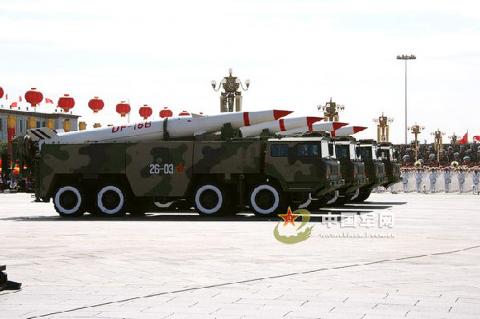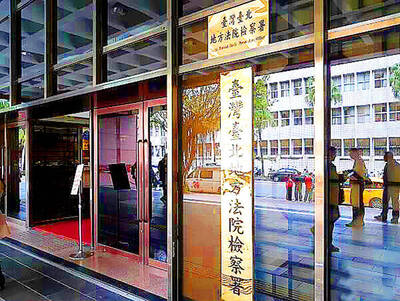A new longer-range ballistic missile allegedly deployed by China and the introduction of multiple warhead capabilities could render obsolete Taiwan’s most advanced missile interceptors, analysts said yesterday.
National Security Bureau (NSB) Director Tsai Der-sheng (蔡得勝) told the legislature on Wednesday that China had recently begun deploying Dong Feng-16 (DF-16) ballistic missiles with a range of between 800km and 1,000km, and that some were targeting Taiwan.
One US expert with years of experience monitoring developments in China’s missile arsenal told the Taipei Times that while literature on the DF-16 was scarce, the fact that a different designation had been referenced implied that the system was sufficiently different from existing missiles.

Photo: China Military Online
Another, Rick Fisher, a senior fellow at the International Assessment and Strategy Center in Washington, said chances the DF-16 is the “real deal” were high, adding that the new system would likely incorporate advances in solid rocket fuel, guidance and warhead design. He admitted this was the first time he had seen references to the DF-16 designation.
Alarmingly, the faster re-entry of a longer-range ballistic missile such as the DF-16 would greatly reduce the effectiveness of Taiwan’s PAC-3 missile interceptors that were acquired at great cost from the US and which are still in the process of being deployed.
The longer the range of a ballistic missile, the higher it must climb to reach its target and the higher it climbs, the more time it takes for it to fall to the ground, giving gravity more time to accelerate the descent of the warhead at a rate of about 9.8m per second squared.
“All the PAC-3s are not yet in the field, but when they are, they can potentially be defeated by the faster 1,000km DF-16,” Fisher said.
In addition, new long-range missiles would give China’s leadership the ability to make “peace gestures,” such as withdrawing older DF-15s, without any substantial reduction of military pressure on Taiwan, he said.
The removal of some missiles targeting Taiwan has been touted as a potential “goodwill” gesture by Beijing to help President Ma Ying-jeou (馬英九) get re-elected next year.
Ballistic missiles with a range such as that attributed to the DF-16 could be deployed at the Second Artillery’s 52 Base in Anhui Province and target Taiwan as well as US bases in the region, such as Okinawa and Guam.
According to a study by the Project 2049 Institute, 52 Base oversees five short-range ballistic missile (SRBM) brigades and as many as three medium-range ballistic missile brigades. It remains unclear whether 52 Base is being equipped with a new brigade for the DF-16 or whether they would replace older SRBMs.
Wendell Minnick, Asia bureau chief for Defense News, was more skeptical on the DF-16 representing a new type of missile, saying it was likely a variant of the existing DF-15, which has a range of about 600km.
“Honestly, I can’t see how all the US analysts missed it, if it is ‘deployed,’” Minnick said. “I suspect he [Tsai] is saying the DF-15 extended range is the new ‘DF-16,’ but the lack of details during his testimony annoys me to no end.”
“It’s possible they [the government] are trying to scare the US into releasing new F-16 fighters and submarines,” Minnick said.
During his presentation, Tsai also said that most of China’s missiles now had multiple warheads capable of hitting different targets, such as radar sites and planes at airports.
While it is known that the DF-21 “aircraft carrier killer” — which Tsai said was also recently deployed — has multiple warheads, news that smaller missiles in the Chinese arsenal have multiple reentry vehicles (MRVs) would be a worrying development, Fisher said.
“PAC-3s can only handle one incoming missile target, not [several] MRVs,” he said, adding that the US had recently canceled a missile defense program intended to give missile interceptors the ability to take out MRVs.

Intelligence agents have recorded 510,000 instances of “controversial information” being spread online by the Chinese Communist Party (CCP) so far this year, the National Security Bureau (NSB) said in a report yesterday, as it warned of artificial intelligence (AI) being employed to generate destabilizing misinformation. The bureau submitted a written report to the Legislative Yuan in preparation for National Security Bureau Director-General Tsai Ming-yen’s (蔡明彥) appearance before the Foreign Affairs and National Defense Committee today. The CCP has been using cognitive warfare to divide Taiwanese society by commenting on controversial issues such as Taiwan Semiconductor Manufacturing Co’s (TSMC, 台積電) investments in the

HELPING HAND: The steering committee of the National Stabilization Fund is expected to hold a meeting to discuss how and when to utilize the fund to help buffer the sell-off The TAIEX plunged 2,065.87 points, or 9.7 percent, to close at 19,232.35 yesterday, the highest single-day percentage loss on record, as investors braced for US President Donald Trump’s tariffs after an extended holiday weekend. Amid the pessimistic atmosphere, 945 listed companies led by large-cap stocks — including Taiwan Semiconductor Manufacturing Co (TSMC, 台積電), Hon Hai Precision Industry Co (鴻海精密) and Largan Precision Co (大立光) — fell by the daily maximum of 10 percent at the close, Taiwan Stock Exchange data showed. The number of listed companies ending limit-down set a new record, the exchange said. The TAIEX plunged by daily maxiumu in just

‘COMPREHENSIVE PLAN’: Lin Chia-lung said that the government was ready to talk about a variety of issues, including investment in and purchases from the US The National Stabilization Fund (NSF) yesterday announced that it would step in to staunch stock market losses for the ninth time in the nation’s history. An NSF board meeting, originally scheduled for Monday next week, was moved to yesterday after stocks plummeted in the wake of US President Donald Trump’s announcement of 32 percent tariffs on Taiwan on Wednesday last week. Board members voted to support the stock market with the NT$500 billion (US$15.15 billion) fund, with injections of funds to begin as soon as today. The NSF in 2000 injected NT$120 billion to stabilize stocks, the most ever. The lowest amount it

INVESTIGATION: The case is the latest instance of a DPP figure being implicated in an espionage network accused of allegedly leaking information to Chinese intelligence Democratic Progressive Party (DPP) member Ho Jen-chieh (何仁傑) was detained and held incommunicado yesterday on suspicion of spying for China during his tenure as assistant to then-minister of foreign affairs Joseph Wu (吳釗燮). The Taipei District Prosecutors’ Office said Ho was implicated during its investigation into alleged spying activities by former Presidential Office consultant Wu Shang-yu (吳尚雨). Prosecutors said there is reason to believe Ho breached the National Security Act (國家安全法) by leaking classified Ministry of Foreign Affairs information to Chinese intelligence. Following interrogation, prosecutors petitioned the Taipei District Court to detain Ho, citing concerns over potential collusion or tampering of evidence. The